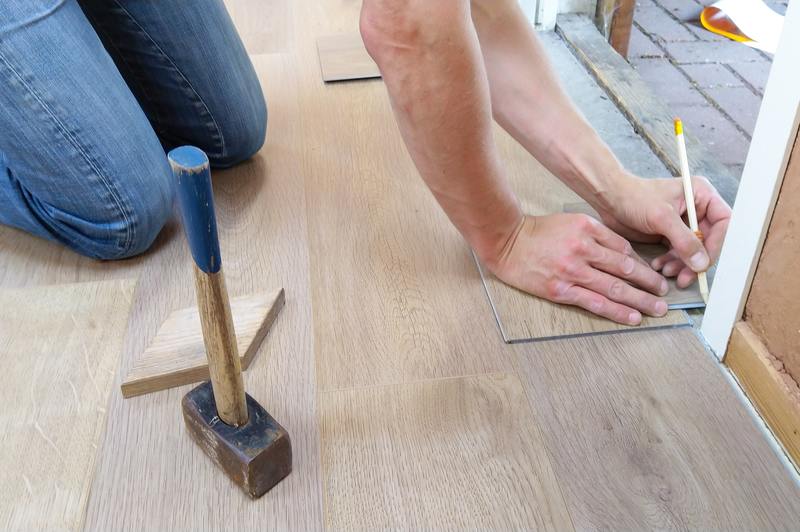If you find yourself asking who to call to replace water damaged floors, then the answer is simple: a plumber and a contractor. However, knowing who to call is just as important as knowing when the time is right for replacing floors.
Sometimes, water damage is not as extensive and destructive as you think, and you can repair the flooring yourself. If you believe that your floors are damaged beyond fixing, continue reading to learn everything there is to know about the people who can help you replace your floors.

Who Should You Call To Replace Water-Damaged Floors?
If you need help in replacing your water-damaged flooring, you should call these people in order:
Step #1. Call your plumber
If you see the telltale signs of water damage, you should find and fix the source of the problem as soon as possible. Sometimes, the source is right in the open, such as in the case of leaking ceilings.
However, there are times that the problem is invisible. If you cannot see where the water is coming from, then you should call your plumber.
Invisible sources of water damage are often leaking or burst pipes. This happens most likely near your washing machine, bathroom, or dishwasher.
Your plumber will be more than happy to find and repair the source of the leakage. In doing so, you can prevent further damage and expenses.
Step #2. Call your insurance provider
If you have insurance for your home, you can check your policy to see if accidental water damages are included in your insurance coverage. If you find that it is part of the policy, you should contact your insurance provider or lawyer to see your next steps in getting compensation.
Step #3. Call your contractors
Now that the source of the water damage is fixed, it is time to replace your floors. There are multiple types of contractors, but often, the only contractor you need is a general contractor.
A general contractor is equipped with fundamental construction skills to replace water-damaged floors. However, if the damage is severe and extensive, he also has enough management and budgeting skills to provide a complete overhaul and replacement by hiring subcontractors.
If you are a general contractor or want to skip hiring one, you can directly contact the contractors specializing in floorings. These specialists are rightfully named flooring contractors, with each having their expertise.
Generally speaking, the flooring contractors can help you replace any type of floor — from hardwood to vinyl and tiles. They may also be able to help you repair your subfloor in case it has been damaged.
Step #4. Call mold and mildew remediation specialists
Usually, mold or mildew growth can be removed using household items and over-the-counter products. However, if you or your contractor noticed a foul, musty odor or discovered massive mold growth, then it would be best to call professionals.
Mold and mildew specialists are licensed tradesmen who can safely and effectively eliminate all potential health hazards in your home. Although they can be expensive at times, they are necessary to keep you and your home safe and healthy.
When Should You Call For Help In Replacing Floors?
Getting professional help is great for solving your problems, but sometimes their services are not yet necessary. Before you call for specialists, it would be best to check your floors for the signs of severe water damage to avoid paying hefty fees.
When you see the following signs, there is a high chance that your floors are beyond repair and require replacement.
1. Dirty water
Often, clean water spilling or leaking onto your floor is no cause for concern. However, if you saw that the water is gray or black, then that might hint that the leaking water is contaminated.
Gray water usually indicates contaminants such as soap, but black water means that the water came from sewage. If that is the case, it would be best to contact your contractors immediately.
2. Buckling
When your floors peel away and begin curving upwards, then your wood or tile floor needs to be replaced. Usually, this means that the water reached deep enough to separate your finished floor from your subfloor.
3. Warping
Any significant change in shape indicates the need for floor replacement. These changes can look like depressions in the middle of the panel, bubbling, cracking, or peeling.
4. Discoloration
After being soaked, your floors can change colors. If your floors are wood, you can see the panels get darker due to the absorbed moisture.
If your floors are still discolored after a day or two, then you might be looking at the signs of mold growth. It would be best to replace the panels immediately.
5. Foul odor
If you smell an unusual odor emanating from your floor but you cannot see any discoloration, it would be best to contact your contractor and mold removal specialists. Unpleasant, musty odors are indicative of mold and mildew growth.
If you cannot see any signs of mold, then they might be growing underneath your floorboards. You should have the hazards removed before it spreads even further.
Conclusion
Knowing who to call to replace water damaged floors can help you deal with your construction needs as soon as possible. Professional contractors, mold removers, and your insurance provider should be kept at the ready in case you need repairs that could save your home and protect your health.
